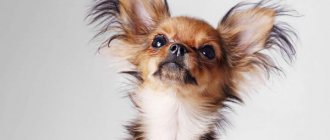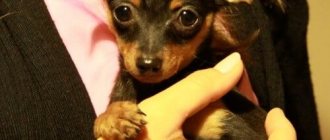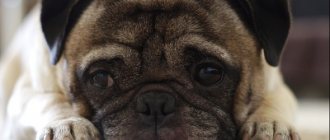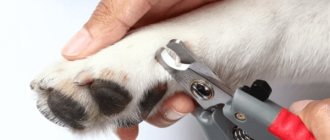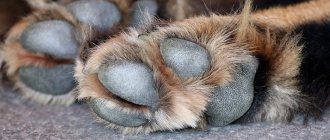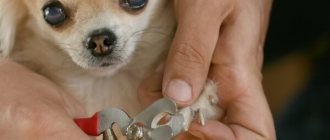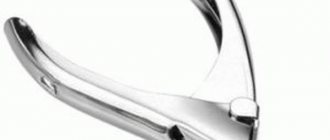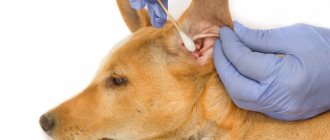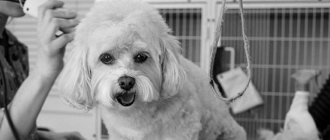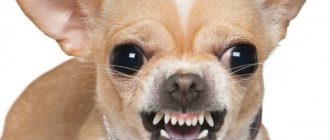Like all dogs, Spitz dogs need periodic trim nails. This is done because the claws do not have time to wear down, no matter how active the walks are. And if the claws grow to a large length, they begin to interfere with the dog’s walking, leading to lameness and, ultimately, to problems with the joints. Long nails dig into soft tissue, causing pain.
If a long claw is broken, it will have to be removed surgically. Another disadvantage is that in long claws the vessel gradually grows towards the end of the claw - this will complicate the claw trimming procedure in the future, as it will increase the likelihood of damage to the blood vessels.
Your Spitz should be taught this procedure from early childhood.
You can trim the claws yourself, or you can entrust this procedure to a professional.
Once every week or two, pay attention to your dog’s nails - is it time to shorten them?
If you notice that your Pomeranian's claws have grown too much, before you begin the procedure, you need to know what tools to use. All pet stores sell special nail clippers; for Spitz, nail clippers for small dogs and cats . The wire cutters that you and I use are completely unsuitable for these purposes.
Nail clipper for Pomeranian
You also need to have an idea of the structure of the claw, because the blood vessels and nerve are located very close to them. The living place in the claw is called the pulp.
The procedure is best carried out on a special grooming table ; the place should be very well lit. hemostatic agents on hand - powder, potassium permanganate crystals or hydrogen peroxide.
If necessary, trim off any excess hair on your baby's toes first to expose the nails.
To carefully trim the nail without damaging the pulp, take the Pomeranian's paw, press lightly on the pad to better expose the nails, look at the light and determine where the live part of the nail ends (it will be much darker than the main nail). Take a nail cutter and cut the nail about 1mm, so as not to touch the pulp.
Trimming Spitz's nails
If you are the owner of a Pomeranian with light hair, it will be easier for you to see the pulp on your pet's nails. If the dog wears a dark coat, it will be more difficult to determine the boundary, so it is better to trim the nails more often, but little by little - gradually you will find the right place.
Once all the nails are trimmed, take a nail file (human nail file, which is meant for artificial nails) and file them down to make them smooth.
File for processing a trimmed claw
If it does happen that you accidentally touched the pulp and blood comes out of the claw, don’t worry, take a cotton swab with potassium permanganate powder (or something similar) and apply it to the wound. Hold this for a few seconds, and then make sure that this place does not come into contact with water.
Constant nail trimming will cause the pulp to gradually move back, deeper into the nail, giving your dog complete freedom of movement.
In addition, decorative manicure - applying varnish to the claws. This is done for aesthetic purposes and for practical purposes: with the help of varnish you can emphasize the color of the claws or hide pigmentation flaws. In addition to varnish of various colors, rhinestones are also used. Such a beautiful coating will protect the claws from water and dirt during walks.
How often should you trim your hair?
Typically, dogs that lead an active lifestyle wear down their claws on their own by running on the asphalt or digging in the ground. For everyone else, nail trimming is a mandatory procedure. This allows you to avoid injuries that the animal may receive.
Claws that are too long can cause serious injury and even deformation of the paw. For example, a pet may accidentally pull out a claw by catching it on a carpet or sofa.
A very large length prevents animals from moving normally, because untrimmed claws tend to bend and harden, which leads to incorrect positioning of the paws. To avoid this, constantly check your pet’s paws, because small breeds’ claws grow back quite quickly due to the animal’s low weight and lack of natural grinding.
Important ! Overgrown claws need to be trimmed once every one or two weeks, depending on the intensity of your walks.
Observe the baby carefully; if the gait has changed and the puppy begins to click on the floor, immediately carry out a hygiene procedure.
Recommendations
It is necessary to accustom your Spitz to trimming its nails from puppyhood. The procedure should be carried out for the first time in a comfortable, playful manner for the pet. It is important that the puppy trusts the owner and is not afraid of cutting.
If you trim your Spitz's claws at least once every 2 weeks, then the inner layer, filled with capillaries, begins to gradually shorten and go deeper. The risk of hitting blood vessels is reduced. Therefore, it is important to perform pedicures regularly and periodically check your Pomeranian's paws.
If your pet starts clicking and gnawing on the paw area, then it’s time to carry out the procedure.
To learn how to cut your Spitz's nails correctly, it is advisable to entrust your dog's first pedicure to a groomer or veterinarian. After observing the actions of a specialist, you can later try to carry out the procedure at home yourself.
It is important not only to trim the horn formations in a timely manner. It is recommended to periodically trim the fur around your pet's toes. This will facilitate the process of trimming the horny plates and give the paw a well-groomed appearance.
What is needed for the procedure
If you decide to trim the nails of a puppy or an adult dog at home, prepare the necessary tools in advance so that during the trimming process you do not have to waste time searching and thereby irritate the dog, otherwise it may begin to resist.
To carry out the procedure you need to prepare:
- nail clipper;
- nail file;
- cotton pads;
- antiseptic;
- hemostatic agent.
Do not use regular scissors or nail clippers from a manicure set. They do not cut, but shred, which is why the claw begins to crumble, peel, and burrs appear.
Preparing for nail trimming
The breeder can take care of the pets' paws independently. The procedure is carried out once every two weeks or a month. Most likely, in winter you will have to trim your claws more often, since they are difficult to grind down at this time. The same thing is observed in puppies that are constantly indoors.
Before cutting your Pomeranian's nails, prepare:
- nail clipper (sold in pet stores and veterinary pharmacies);
- hydrogen peroxide, iodine, potassium permanganate, baby powder to stop possible bleeding;
- cotton buds;
- varnish if you want to give your dog a manicure;
- a treat for a pet that has patiently undergone the procedure.
Step-by-step instructions for trimming claws
If it is not possible to take your dog to the salon, you can perform the procedure at home. You can see how to trim claws correctly in the instructional photo and video.
The algorithm of actions is quite simple:
- Wash the paws and trim the fur between the toes.
- Take the paw in your hands, holding it just above the ankle. Fix the claw and carefully “bite off” its tip with a nail clipper at an angle of 45 degrees.
- Do the same with all the nails.
- Then sharpen them with a nail file, giving them an oval shape.
Important ! After completing the procedure, be sure to praise your pet and treat it with a treat.
Before you begin, determine where the blood vessel is so as not to damage it, otherwise bleeding will begin:
Trimming scheme
Why trim your nails?
A dog's overgrown, unkempt claws can become a source of serious illness. Infections, growths, pustules - all this lies in wait for a Spitz with untrimmed claws. At the same time, long claws cause serious discomfort to such an active and energetic dog; they affect its gait, disrupt its posture and general muscle tone.
In addition, in the house an active Spitz often becomes a companion to any children's games. And its long claws can seriously injure its little owner. Timely trimming of nails will protect not only the owner’s skin, but also the surface of the furniture.
Not everyone takes such a procedure as nail trimming seriously. Some owners do not see the need for this, citing as justification that, for example, no one takes care of the claws of a stray dog, and its paws are in good condition. Meanwhile, in nature, animals, including stray dogs, wear their claws off on asphalt, trees and other hard surfaces. The domestic Spitz does not have this opportunity, and therefore the owner must monitor the condition of his claws.
Too long nails interfere with the dog's walking, his toes hurt, hair grows between them, and subcutaneous mites or fungus appear . All this leads to the fact that the dog begins to bite off its own nails. Seeing this behavior, the owner should take the pet to a veterinarian. The fact is that nail biting is typical not only for animals with long claws, but also for dogs that have parasites.
A veterinarian will conduct a thorough examination, name the exact reason for this behavior, prescribe appropriate treatment and perform paw hygiene and nail trimming.
You should always remember that in addition to food, walks and hair trimming, every pet needs nail care.
Possible problems and solutions
You may encounter resistance from the dog, because this procedure is quite unpleasant for him. Calm your baby to prevent him from getting injured.
- Spitz dogs have dark claws, which makes it difficult to see the beginning of the pulp and correctly measure the distance to it. Therefore, unexpected situations may arise.
- If your Pomeranian jerks excessively and does not allow his nails to be trimmed, wrap him in a swaddle and secure him on your lap.
- When you are confident that you are doing everything correctly, but the animal begins to whine (even when you did not touch the nail bed), most likely he is highly sensitive. Use Lidocaine solution as a pre-treatment before the procedure.
- If the claws are very hard and the nail clipper cannot do the job, cut off the entire length with a regular nail file.
Before performing the procedure yourself, go to an appointment with a veterinarian and see what actions the specialist does and in what sequence.
How to position and train your dog for nail trimming
If you decide to take full care of your pet, then grooming of the claws cannot be avoided. This means that you should immediately start accustoming him to a haircut. The dog must get used to the procedure from childhood. And since such manipulations cannot be avoided, you need not to be afraid yourself - your friend will get nervous if you worry.
You cannot be impatient or aggressive. The family's favorite will not be able to understand what they want from him, and will be even more afraid. The puppy may become nervous, begin to struggle, get angry and whine. Such a beginning of acquaintance with grooming will scare off the dog, and all subsequent procedures for caring for the animal will be viewed with hostility.
Hasty actions are excluded: the decision to do everything faster results in mistakes and pain for the animal.
First we establish psychological contact. The puppy should not be afraid of touching his paws, so a week before the “X” day, we begin to stroke his paws and touch the pads.
Sit more often next to the dog or near it - you need to be on the same level. While talking or playing, stroke the paws, pick them up, stroke the pads and claws. This will relax the dog, he will not see a threat in such touches in the future.
The haircut should be done at a moment of calm in the house, when the dog has eaten and generally looks content and peaceful. To begin with, the pet is walked so that all basic needs are met. When he gets some exercise and gets a little tired, his reaction to the procedure will be calmer. If this is a young dog or an active puppy, then walking before the procedure is mandatory!
They talk to the dog and pet it before and during work. There is no need to do anything with a restless dog!
Cost of the procedure
In the cabin
Naturally, the best option would be to take your pet to a salon where experienced specialists will quickly and painlessly perform the procedure. At the same time, cutting nails in Moscow is not very expensive. Prices range from 150 to 350 rubles.
In the cabin
At home
If for some reason you cannot bring your dog to the salon, call a specialist to your home. This will allow you to get a lot of advantages:
- saving travel time;
- a familiar environment for the dog and a minimum of discomfort;
- lack of encounters with other animals;
- opportunity to observe the progress of the procedure;
- affordable prices.
The cost of the procedure at home is slightly higher than in the salon, and can reach up to 500 rubles.
You should always remember that in addition to food, walks and hair trimming, every pet needs nail care.
The pet’s health also depends on timeliness and quality - overgrown claws can grow into the paw pads, which in turn can lead to inflammation and suppuration. The dog may lose its springy, light gait, because the main emphasis when moving is on the claws, and not on the base of the paws.
If necessary?
The answer to the question of whether dogs need to have their nails trimmed is definitely positive. And Spitz are no exception. These cute, fluffy and miniature dogs always delight others with their appearance. But it’s not just wool that requires attention.
Spitz dogs need to have their nails trimmed periodically. They simply do not have time to wear down, despite the dog’s frequent walks and activity. If the claws grow, they lead to discomfort: it becomes uncomfortable and painful for the dog to walk, lameness may appear and, as a result, problems with the joints.
Proper execution at home
Trimming your Spitz's nails yourself is a fairly simple process if you prepare for it correctly. First, you need to prepare all the necessary tools:
- a guillotine-type nail clipper with rubberized metal handles so that it does not slip in your hands;
- a regular nail file with a large coating;
- cotton pads;
- antiseptic (alcohol, chlorhexidine, hydrogen peroxide);
- hemostatic agents: talc or potassium permanganate powder (preferably in a bottle for ease of use).
Secondly, the work place should be well lit. The Spitz can be placed on a table, the floor, or simply placed on your lap.
Thirdly, you need to trim the long hair on the pads and between the toes. This will make further work much easier.
When all the necessary tools are ready, you can proceed directly to the haircut. Press on the pad to make the claw easier to see. In the light, determine where the horny part ends (it will be lighter than the living part). Cut the tip about 1 millimeter at an angle of 45 towards the inside of the foot.
Necessary tools
Before trimming your dog’s nails, you need to stock up on the entire arsenal of handy tools that will be needed during the procedure. You will need:
- nail clipper;
- scissors;
- grinder or sharpener;
- antiseptic;
- cotton pads or sticks.
A nail clipper can be purchased at any pet store or veterinary clinic. It is recommended to choose pliers for small breeds with a limiter. This will help trim the horny formations correctly.
A steel nail clipper is best suited: it does not dull, does not bend, and therefore will not cause discomfort to the animal during trimming.
Scissors are needed to trim the fur between the toes and on the pads of the paws.
A grinder is an electric sharpener that you use to sand down sharp edges after trimming. On sale you can find devices from such brands as Pedi Paws, Master Grooming, Pet Nail Trimmer Grinder.
Electric scratching posts can replace nail trimming. However, your dog will need pedicures much more often.
You can replace the grinder with a special sharpener for animals. However, such a tool is less efficient and will require more polishing time.
Hydrogen peroxide, brilliant green or dry potassium permanganate are used as an antiseptic and hemostatic agent in case of capillary damage.
The product is used to cauterize the bleeding area. After the bleeding stops, it is recommended to wash off the potassium permanganate so that the pet cannot lick it off.
You can purchase specialized hemostatic agents at the pet store. Bio-Groom Sure Clot powder has proven itself well among groomers.
If your hand trembled?
Even an experienced groomer can touch living tissue and damage a blood vessel, let alone the owner of the Spitz. There's nothing wrong with that. The wound must be immediately treated with any antiseptic. Then you need to hold it for a few seconds with a cotton swab containing potassium permanganate. If the bleeding cannot be stopped, the dog is immediately sent to a veterinary clinic for qualified assistance.
What you should know about the structure of a dog's claw
The Spitz claw has a hard outer shell and a soft inner layer called pulp. The latter contains many capillaries (blood vessels). The regrowth of the pulp occurs simultaneously with the outer hard shell.
If the stratum corneum is cut too short, there is a risk of touching the capillaries. Therefore, it is important to know how to trim your nails correctly without damaging the blood vessels.
How often is it needed?
Experts advise trimming Spitz's nails once every three weeks. You can cut less nails and do it more often. In any case, once every two weeks you should check the condition of your pet’s paws to see if there are any splits or breaks.
From how many months?
It is important to remember that you need to accustom your Spitz to a haircut from a young age, then the older one will not have problems. Some breeders begin grooming even on the tenth day of a pet's life.
So, what should you do to train your puppy:
- Classes must be carried out daily in a playful and friendly manner so that the puppy trusts you. If something goes wrong or does not work out, you need to interrupt the lesson for a while.
- The dog should be accustomed to the sight of the nail clipper and its sound - so it will understand that there is no danger for it. Start by simply cutting something in her presence.
- The next stage is cutting the fur on the paw. If your Spitz behaves calmly and well, reinforce this with a treat. If he doesn’t like something, then release the puppy and forget about the procedure for a while.
- When the hair trimming is successful, you can move on to trimming the claws. Trim the very tip of one claw and be sure to give him a treat. It is important to remember that you should not try to trim all the claws at once - this may simply scare or anger the baby.
Once again about the pulp
The most difficult thing in the process of trimming a Spitz's nails is determining the boundary of the pulp. In light-colored dogs it is clearly visible, but in pets with dark hair it is much worse.
To find out where the living part of the claw ends, it is better to examine it from the underside (to do this you will have to turn the Spitz on its back). Sometimes, after cutting off a small section, you can see a dark circle on the remaining surface of the claw. This means that the blood vessels are very close and there is no need to cut off any more.
Over time, if you trim the nails regularly, the pulp will move and the nail trimming procedure will become easier.
tags veterinarian color fear wool
What if it's broken?
If you suddenly notice that your pet has begun to limp, refuses to run and constantly licks its paw, most likely it has broken a claw. What to do in this case?
On the edge
First of all, it is important to determine the extent of damage to the claw. If only the cornea is broken, then there is nothing to worry about. Just trim the bumps and file the nail.
At the base
If the pulp is damaged and bleeding comes from the wound, then you need to immediately take action - stop the bleeding with hydrogen peroxide and a cotton pad.
Then you need to lubricate the damaged area with iodine or brilliant green and bandage it (put on a sock), and put a bag on top to avoid infection. It is not recommended to trim the claw in this situation!
If the bleeding cannot be stopped for more than 10 minutes or the Spitz simply does not allow it to be done (bites, breaks out or does not give its paw), you must take the pet to the veterinarian. He will be able to assess the extent of damage and prescribe the correct treatment.
Stages of processing Spitz claws
The process itself looks like this:
- Place the dog on a well-lit table.
- Take the paw and gently press down on the pad to expose the claws.
- Determine where the pulp ends - the living part of the nail, rich in nerve endings and blood vessels. It is darker than the rest of the claw.
- With confident movements, cut off a small part of the horny tip, being careful not to touch the pulp. Particular attention is paid to the claws on the lateral toes - they hardly wear down and can grow into the skin, causing infection. The claw cannot be cut close to the pulp - a distance of approximately 2 mm should remain.
- If the claw bleeds, it means the blood vessels are damaged. Carefully treat the wound with hydrogen peroxide or iodine, then apply powder or potassium permanganate to a cotton swab and press onto the damaged area for a few seconds. The paw should not be wet for some time.
- File your nails with a regular nail file to make them smooth.
- The haircut ends with the application of hairspray, if, of course, you have such a desire.
